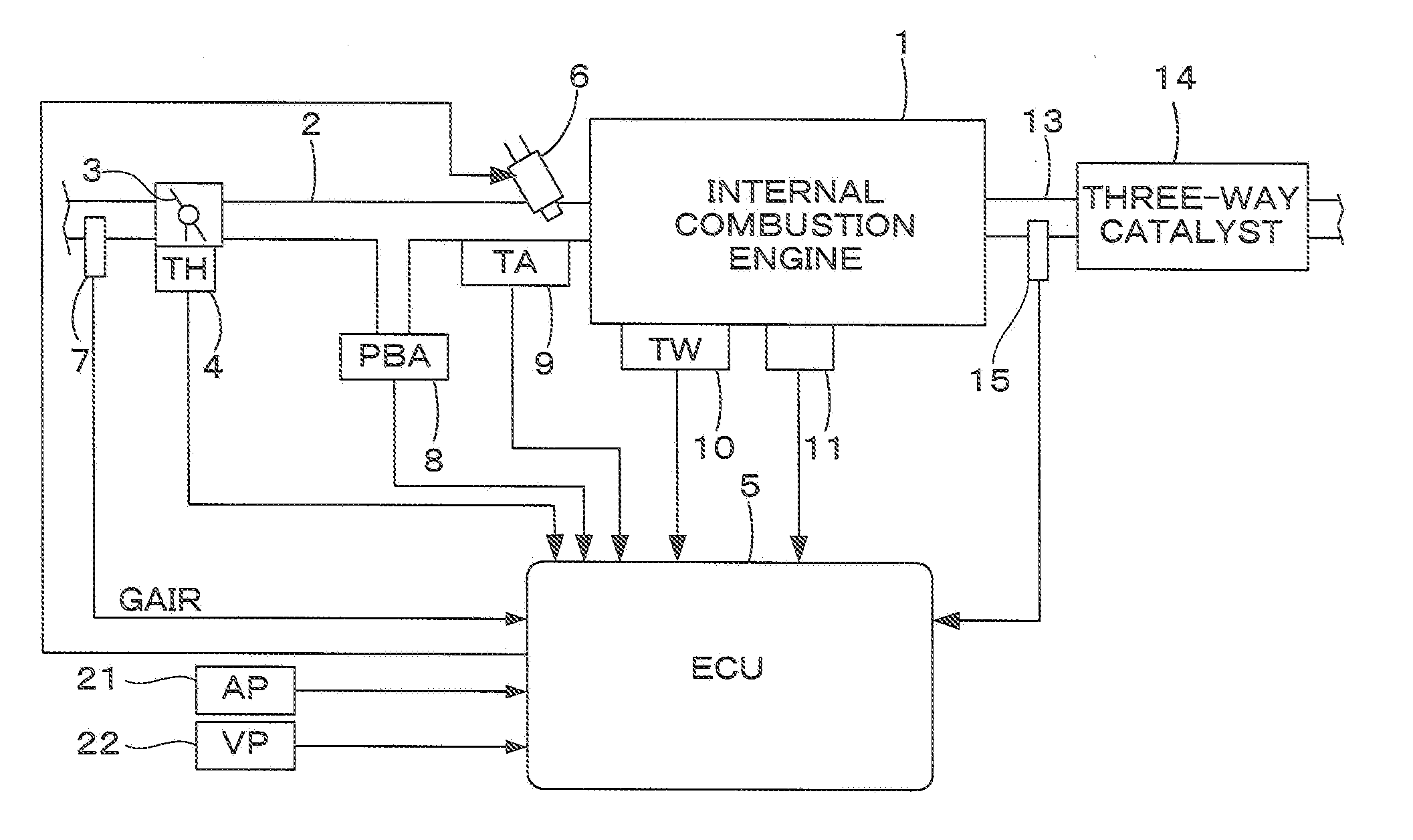Air-fuel ratio control system for internal combustion engine
a technology of air-fuel ratio and control system, which is applied in the direction of electric control, machines/engines, mechanical equipment, etc., can solve the problems of imbalance in air-fuel ratio, rt accuracy, and the inability to accurately determine the failure of the imbalance, so as to improve the range of calculated determination parameter values, reduce the range of calculation parameter values, and improve the effect of determination accuracy
- Summary
- Abstract
- Description
- Claims
- Application Information
AI Technical Summary
Benefits of technology
Problems solved by technology
Method used
Image
Examples
first embodiment
[0037]FIG. 1 is a schematic diagram showing a general configuration of an internal combustion engine (hereinafter referred to as “engine”) and an air-fuel ratio control system therefor, according to one embodiment of the present invention. The engine is, for example, a four-cylinder engine 1 having an intake pipe 2 provided with a throttle valve 3. A throttle valve opening sensor 4 for detecting a throttle valve opening TH is connected to the throttle valve 3, and the detection-signal is supplied to an electronic control unit 5 (hereinafter referred to as “ECU”).
[0038]Fuel injection valves 6 are inserted into the intake pipe 2 at locations intermediate between the cylinder block of the engine 1 and the throttle valve 3 and slightly upstream of the respective intake valves (not shown). These fuel injection valves 6 are connected to a fuel pump (not shown) and electrically connected to the ECU 5. A valve opening period of each fuel injection valve 6 is controlled by a signal output fr...
second embodiment
[0086]FIG. 6 shows a configuration of an internal combustion engine and an air-fuel ratio control system according to the second embodiment of the present invention. The air-fuel ratio control system shown in FIG. 6 is obtained by adding a binary type oxygen concentration sensor (hereinafter referred to as “O2 sensor”) 16 disposed downstream of the three-way catalyst 14 in the system of FIG. 1. The detection signal of the O2 sensor 16 is supplied to the ECU 5. This embodiment is the same as the first embodiment except for the points described below.
[0087]The O2 sensor 16 has a characteristic such that the sensor output VO2 rapidly changes when the air-fuel ratio AF is in the vicinity of the stoichiometric ratio AFST. Specifically, the O2 sensor output VO2 is high if the air-fuel ratio AF is richer than the stoichiometric ratio AFST, whereas VO2 is low if the air-fuel ratio AF is leaner than the stoichiometric ratio AFST.
[0088]In this embodiment, the LAF feedback control is performed...
modification 1
[0103]In this embodiment, the air-fuel ratio perturbation control may be performed by the process shown in FIG. 12 instead of the process of FIG. 2. The process of FIG. 12 is obtained by adding step S1a to the process of FIG. 2.
[0104]In step S1a, the DAF table of FIG. 11 is retrieved according to the adaptive law control input UADP to calculate the amplitude DAF. The process thereafter proceeds to step S2.
[0105]The adaptive law control input UADP is calculated during the normal control in which the imbalance failure determination is not performed. Accordingly, by calculating the amplitude DAF according to the adaptive law control input UADP when the execution condition of the imbalance failure determination is satisfied, and performing the air-fuel ratio perturbation control using the calculated amplitude DAF, the air-fuel ratio perturbation control can be performed more appropriately.
[0106]In this modification, step S1a of FIG. 12 corresponds to the amplitude setting means.
PUM
 Login to View More
Login to View More Abstract
Description
Claims
Application Information
 Login to View More
Login to View More - R&D
- Intellectual Property
- Life Sciences
- Materials
- Tech Scout
- Unparalleled Data Quality
- Higher Quality Content
- 60% Fewer Hallucinations
Browse by: Latest US Patents, China's latest patents, Technical Efficacy Thesaurus, Application Domain, Technology Topic, Popular Technical Reports.
© 2025 PatSnap. All rights reserved.Legal|Privacy policy|Modern Slavery Act Transparency Statement|Sitemap|About US| Contact US: help@patsnap.com



